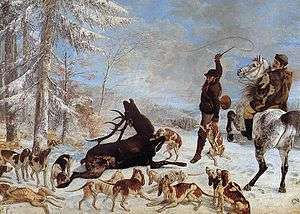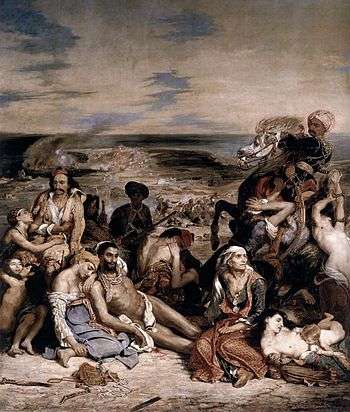The kill of deer
 | |
| Artist | Gustave Courbet |
|---|---|
| Year | about 1867 |
| Medium | Oil on canvas |
| Dimensions | 355 cm × 505 cm (140 in × 199 in) |
| Location | Museum of Fine Arts of Besançon, Besançon |
The kill of deer (L'Hallali au cerf in French), is a very large picture (355 by 505 cm), representing a hunting scene, painted in 1867 by Gustave Courbet. The picture is currently on display in the Musée d'Orsay of Paris.
History
The painting was done during the winter of 1866-1867. It is in the large format newly adopted by Courbet, as also in A Burial at Ornans and The Artist's Studio. The work was exhibited at the French art salons and academies of 1869. The picture caused some scandal, major formats being previously reserved for noble history paintings rather than hunting scenes.
Iconography
The scene shows a deer attacked by a pack of hunting dogs and collapsed on the snowy ground. Two characters are on the right. The drill is Cusenier Jules, a resident of Ornans while the man on horseback is Felix Gaudy, of Vuillafans.[1] L'Hallali is in the tradition of representation of the scene hunt, from the seventeenth century. Courbet uses a harsh realistic representation closer to Flemish models. Hunting scenes are common in the paintings of Courbet; every step of the chase is represented
Influences
There is another influence in this painting, that of The Massacre at Chios (1824) by Eugène Delacroix (illustrated). His influence is reflected particularly through the mounted character.[2]
References
- ↑ Pinette, Matthieu; Soulier-François, Françoise (1992). From Belini to Bonnard: Great Masterpieces. Besançon. pp. 184–185.
- ↑ Robinson, Margaret (1990). Courbet's Hunt Scenes: The End of a Tradition. Providence, Rhode Island. pp. 1–24.
